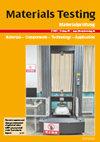SUS430 不锈钢冷轧过程中的平面度缺陷控制
IF 2.4
4区 材料科学
Q2 MATERIALS SCIENCE, CHARACTERIZATION & TESTING
引用次数: 0
摘要
建立了森兹米尔轧机的静力学有限元(FE)模型和动力学有限元模型。其目的是解决 SUS430 不锈钢带冷轧过程中因轧边松动而产生的双边波缺陷。通过调整不同的轧辊轮廓配置,如工作辊辊冠、第二中间惰轮辊冠、第一中间辊锥深和锥度长度,定量分析了轮廓和平整度控制效果。研究了不同轧辊轮廓配置下板带边缘下垂与平整度之间的耦合关系,分析了它们对平整度缺陷控制的影响。第一中间辊锥度深度是控制边缘波的最有效方法。在工业生产线上,第一中间辊锥度从 0.4 毫米调整到 0.6 毫米。整体轮廓改善了 21.5%。带钢边缘的残余应力偏差降低了 32.9%。在 SUS430 不锈钢的工业化生产中取得了极佳的平整度缺陷控制效果。本研究为森兹米尔轧机的平面度缺陷控制技术提供了理论基础和实践经验。本文章由计算机程序翻译,如有差异,请以英文原文为准。
Flatness defect control during cold rolling of SUS430 stainless steel
A statics finite element (FE) model as well as a dynamics FE model for Sendzimir mill have been established. It is in order to solve the bilateral wave defect caused by loose edge rolling during the cold rolling process with SUS430 stainless steel strip. The profile and flatness control effects are quantitatively analyzed by adjusting various roll contour configurations such as work roll crown, the second intermediate idler roll crown, the first intermediate roll taper depth and taper length. The coupling relationship between strip edge-drop and flatness under different roll contour configurations has been studied to analyze their effects on flatness defect control. The first intermediate roll taper depth is the most effective way to control edge wave. The first intermediate roll taper depth has been adjusted from 0.4 mm to 0.6 mm in the industrial production line. The overall profile has been improved by 21.5 %. The deviation of residual stress at strip edges has been reduced by 32.9 %. An excellent flatness defect control result has been achieved for the industrial production of SUS430 stainless steel. The present work is responsible for providing a theoretical basis and practical experience for the flatness defect control technology of a Sendzimir mill.
求助全文
通过发布文献求助,成功后即可免费获取论文全文。
去求助
来源期刊

Materials Testing
工程技术-材料科学:表征与测试
CiteScore
4.20
自引率
36.00%
发文量
165
审稿时长
4-8 weeks
期刊介绍:
Materials Testing is a SCI-listed English language journal dealing with all aspects of material and component testing with a special focus on transfer between laboratory research into industrial application. The journal provides first-hand information on non-destructive, destructive, optical, physical and chemical test procedures. It contains exclusive articles which are peer-reviewed applying respectively high international quality criterions.
 求助内容:
求助内容: 应助结果提醒方式:
应助结果提醒方式:


